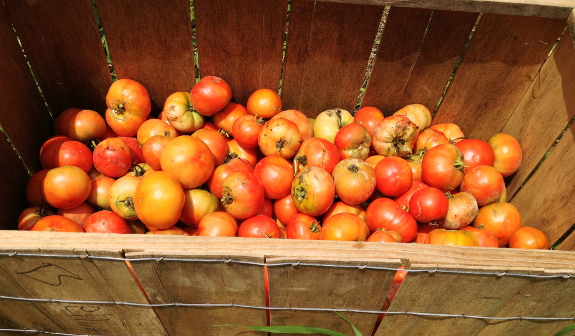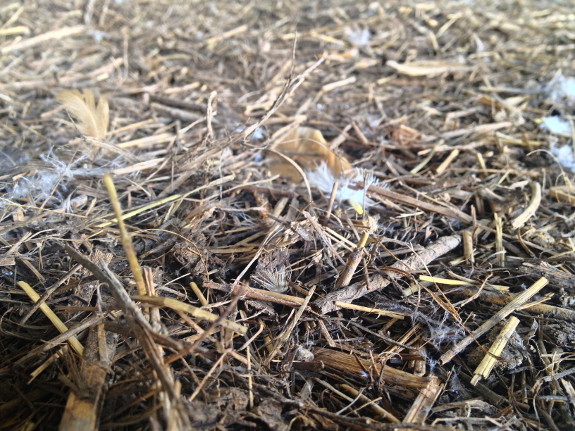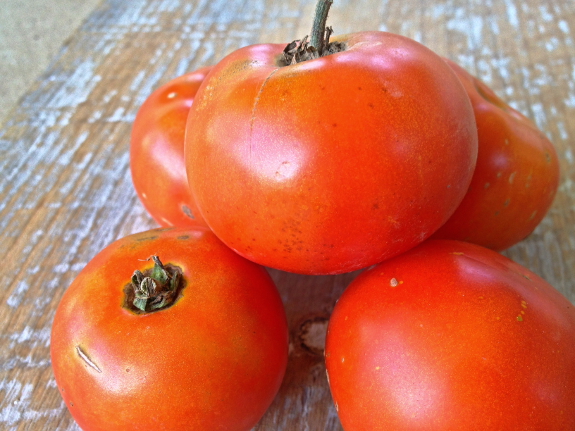
How to harvest the earliest tomato

Having the earliest tomato in my family comes with some pretty big bragging rights, because not only are tomatoes the trophy crop of the garden, but as Anna wrote here, they are necessary for a lot of preserving tasks to come together. Luckily, our farm has been harvesting vine-ripened heirloom tomatoes for 4 weeks now at about 50-60 lbs a week. So, today I want to share my experiences in my quest for the earliest tomato.
The first thing you need to determine is the variety of tomato you wish to use. It is no secret that early tomatoes are typically lacking in flavor, and leave a lot to be desired. So far in my search I have amassed a collection of over 200 varieties that I maintain seed for, and the absolute worse I have tasted is ‘Early Girl’. My notes from a tasting in 2009 (my last year growing it) say this:
“Absolutely no acidity. Overly sweet, reminiscent of refined sugar. Watered down flavor that lacks in all regards. Poor texture, mealy...no better than a grocery tomato.”
My very favorite early variety has been ‘Sasha Altai’, a determinate tomato from Siberia, that is listed as 55 DTM (days to maturity), but came in on day 47 this year. When you first bite into it, the acidity fills your mouth, and as you begin to chew the flesh releases an earthy, satisfying sweetness. It is balanced by a very pleasant texture, and plenty of flavorful juice. Adding salt brings out the sweetness, and really rounds everything out nicely. It is almost as good as many of my late season heirlooms.

The next important thing is your soil. Early tomatoes go through most of the fruiting period during heavy rains, which can quickly leach out nutrients from your soil resulting in cracks, cat facing, and blossom end rot. This is primarily from a lack of calcium and magnesium, which are necessary for strong cell walls that will resist the swelling from excess water uptake. I always recommend composted poultry litter for solanaceous crops as the feathers and such really provide some good levels of Ca and Mg. Average poultry litter has an N-P-K of 3-3-2, and about 2% calcium and .5% magnesium.
The biggest (and easiest) mistake to make is thinking that an early planting will result in earlier tomato harvests, when in fact it can really set you back. Rather than planting by your last frost date, try to wait until the soil is as close to 70 degrees as possible. This year I transplanted mine outdoors at the end of April when the soil was 67 degrees. Nighttime air temps should not drop below 45-50 degrees.

Tips & Tricks
-
Determinate varieties set and ripen in cooler weather.
-
Plant when soil is at least above 55 degrees, and air temps at night no lower than 45 degrees.
-
When planting, bury at least half of the tomato plant.
-
Prune suckers from plants at least once when about a foot tall.
-
Cut the bottom branches off once well established to help prevent fungal infections.
-
Make sure plants get early morning sunlight to dry the leaves as quickly as possible.
-
Amend soil with chicken litter or other high quality compost.
-
Save seeds from the earliest ripe tomato to plant next year. Continue this indefinitely.
 Whether you have 2,000 tomato plants like us, or just 2, these tips
should really help push your harvest a little earlier.
Anyone have a favorite variety to share? Maybe a helpful
trick? Feel free to share with everyone in the comments!
Whether you have 2,000 tomato plants like us, or just 2, these tips
should really help push your harvest a little earlier.
Anyone have a favorite variety to share? Maybe a helpful
trick? Feel free to share with everyone in the comments!
Want more in-depth information? Browse through our books.
Or explore more posts by date or by subject.
About us: Anna Hess and Mark Hamilton spent over a decade living self-sufficiently in the mountains of Virginia before moving north to start over from scratch in the foothills of Ohio. They've experimented with permaculture, no-till gardening, trailersteading, home-based microbusinesses and much more, writing about their adventures in both blogs and books.
Want to be notified when new comments are posted on this page? Click on the RSS button after you add a comment to subscribe to the comment feed, or simply check the box beside "email replies to me" while writing your comment.

Hi
Are there literally 2,000 tomato plants?
That's amazing.
Pat
Michael - While the tomato is my personal favorite food, you are right, what about protein? We believe it is important to acquire our protein from many different sources, and my blog post for this week is actually dedicated to a few of them! Here are the protein sources we currently can easily obtain from our farm: Black Garbanzo beans, pork (we make our own sausage, bacon, and country ham), certified Black Angus cattle (what the majority of our farm is dedicated too), Fish (we have 3 fishing ponds), deer, doves (we stock up heavily in September!),ducks (meat and eggs), chickens (meat and eggs), as well as tree nuts (we have walnut trees. I am sure I left a few out, but that gives you a general idea of some of the things we have in place to ensure our food coffers are always full.
Pat - Sometimes I feel overwhelmed too, but yes, we have over 2,000 tomato plants! Heirloom tomatoes are our primary source of income as we sell them to fine dining restaurants, local grocery stores, put them in CSA baskets (We have 25 families in our CSA program), and have to have enough to make marinara, vodka & arrabiata sauces, pizza sauce, tomato juice, canned crushed tomatoes, and sun-dried tomatoes for our personal use throughout the year... I also put a good helping in my vegetable stock